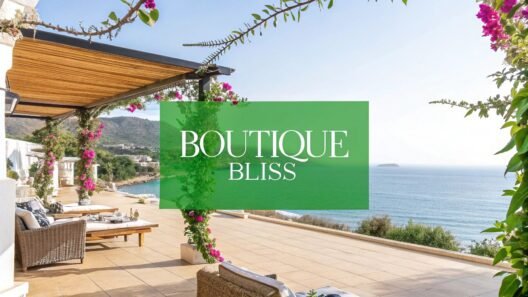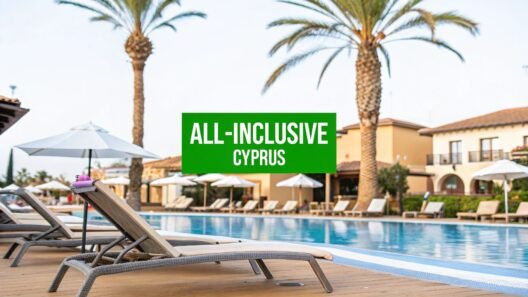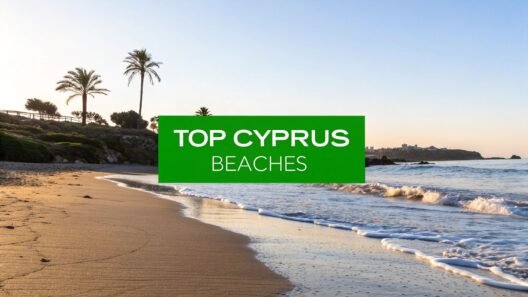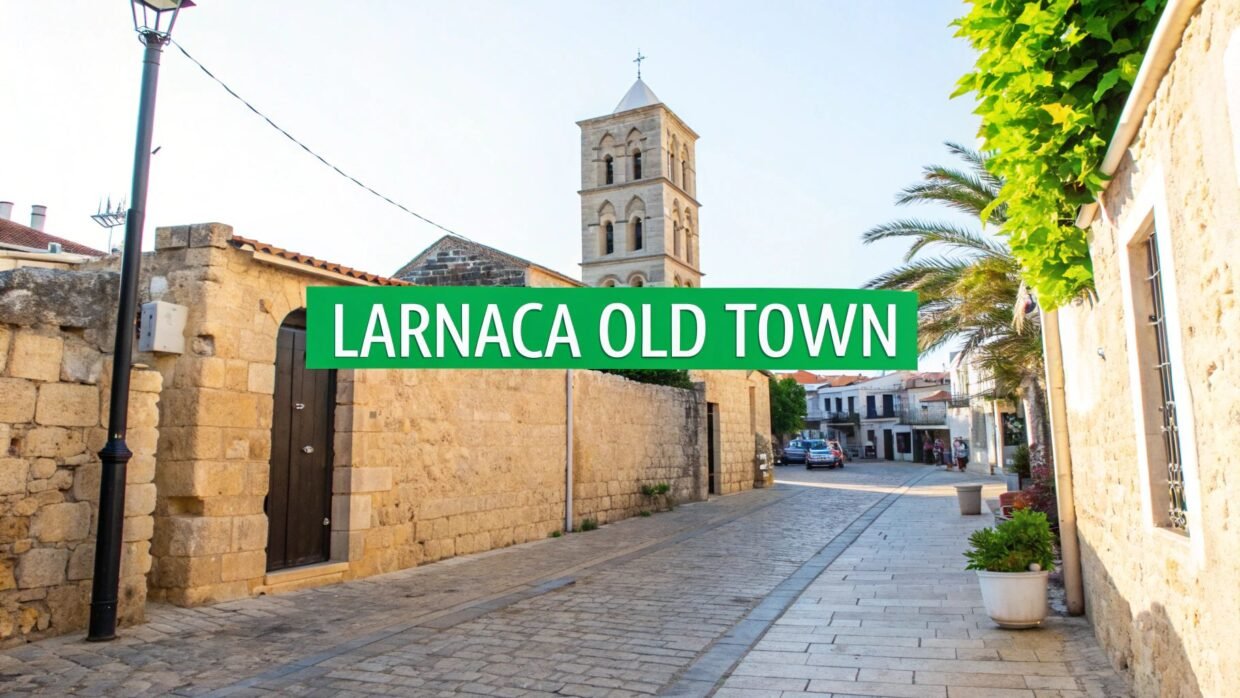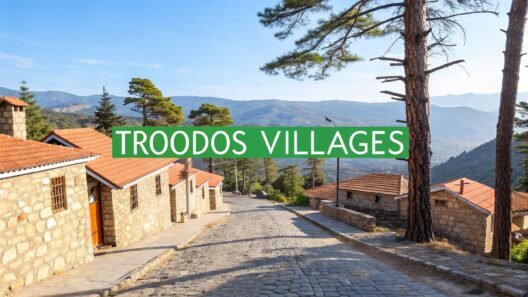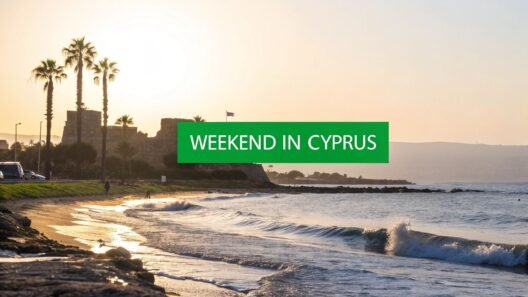Your First Steps Into Living History
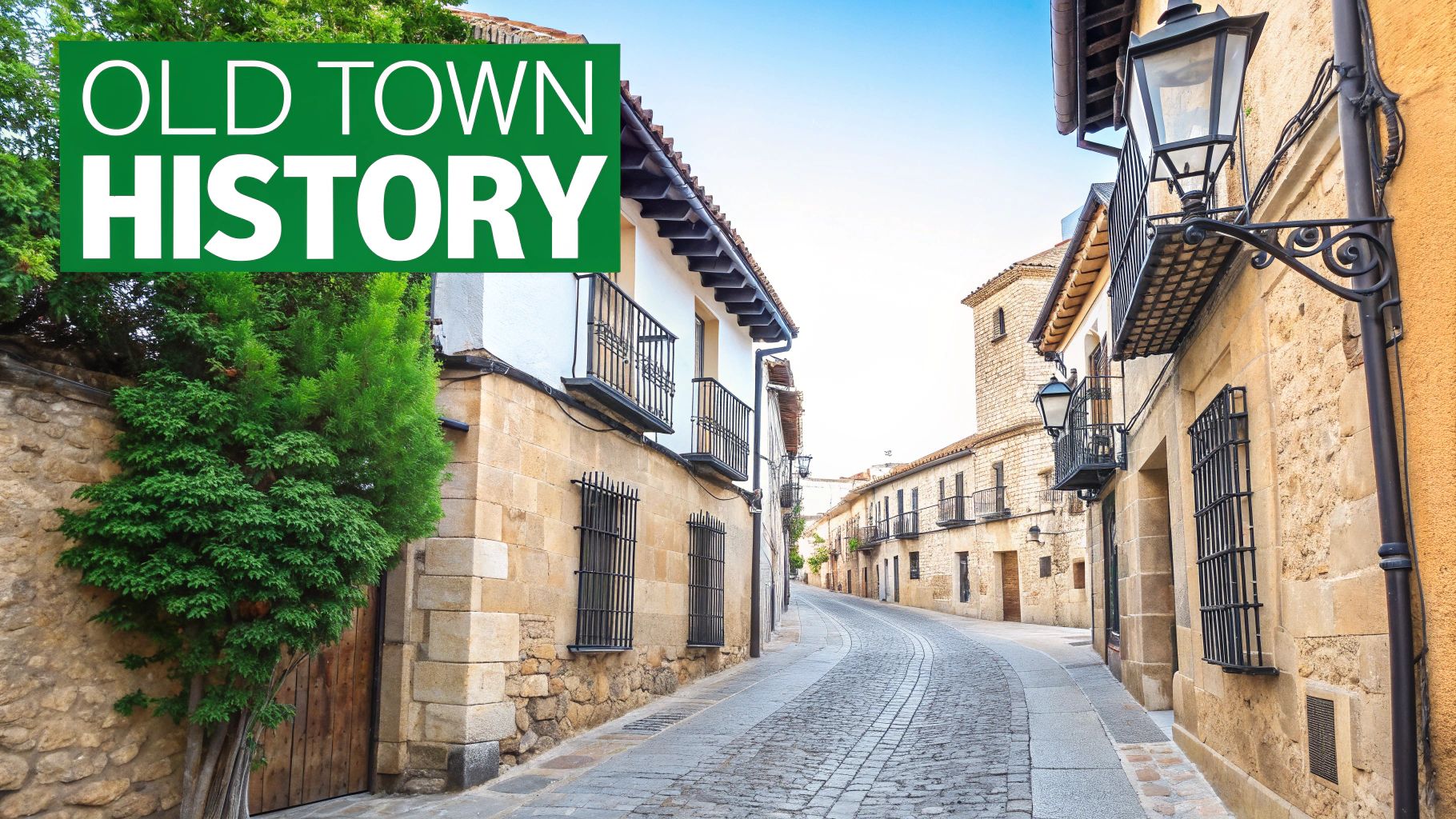
Imagine strolling through a neighbourhood where your footsteps echo those of ancient traders, Byzantine pilgrims, and Ottoman craftspeople. This is the very experience that awaits you in Larnaca Old Town, a place where three millennia of human stories are etched into every corner. This isn't a purpose-built tourist trap with manufactured charm; it’s a living, breathing museum where ancient streets are still home to local families, their daily lives intertwined with the rich historical fabric.
Entering this part of the city is like opening a living history book. You can almost feel the legacy of countless generations in the air. You’ll soon see why travellers consider this corner of Cyprus such a profound cultural encounter. We want to guide you past the obvious sights and help you appreciate the deeper stories that make each weathered stone wall and winding alleyway so special. The real magic of the Larnaca Old Town lies in its authentic, understated character.
A Foundation of Ancient Citium
Beneath the charming, stone-paved streets you walk on today lies a story that stretches back even further. The modern town is built directly upon the foundations of one of the ancient world’s great city-kingdoms. Larnaca Old Town covers much of the ancient city of Citium (also known as Kition), first established by Mycenaean Greeks in the 13th century BCE. This means that as you wander, you are literally walking on layers of history that span more than 3,000 years.
Every civilisation, from Phoenician and Roman to Byzantine and Ottoman, has left its mark, creating a complex archaeological tapestry. You can explore more about this incredible lineage and see for yourself how ancient Citium shaped the city we know today.
What Makes It Special?
What sets this experience apart is the effortless blend of past and present. It is a place where you can:
- Uncover archaeological secrets just a few steps from a modern artisan’s workshop.
- Explore sacred sites that have drawn pilgrims for over a thousand years.
- Feel a tangible connection to history in a way that museums simply cannot replicate.
Whether you are fascinated by ancient legends, religious history, or the simple pleasure of exploring places where history feels alive, this guide will show you both the famous landmarks and the hidden gems cherished by locals. Think of us as your knowledgeable friend, ready to share all the best stories and secret spots.
Walking on Ancient Foundations: The Citium Story
Imagine standing on what is one of the Mediterranean's most significant archaeological sites, where modern excavations continue to reveal astonishing discoveries. The story of Larnaca Old Town begins over 3,000 years ago, when Mycenaean settlers chose this coastal spot to build the ancient city-kingdom of Citium. They established a bustling metropolis that would influence the entire region, setting the stage for the vibrant town you see today.
This ancient city wasn't a simple settlement; it was a powerhouse of its time. Picture it like a historical skyscraper, with each new civilisation building its own floor directly on top of the one before. The Mycenaeans laid the groundwork, the Phoenicians added their layer of maritime trade, and the Romans brought their grand engineering. As you explore the Larnaca Old Town, you are essentially moving through these different levels of history.
The Layers Beneath Your Feet
Recent archaeological work has unearthed massive Cyclopean stone walls – imagine blocks so enormous that ancient Greeks believed only mythical giants could have moved them. These finds point to a sophisticated level of urban planning that would rival any great ancient city. What makes this so fascinating is how these layers reveal a story of cultural exchange and conquest. You don’t need to be an archaeologist to spot the clues:
- Foundation Stones: Look for the oldest, largest stones at the base of some structures. These have witnessed empires rise and fall.
- Architectural Details: Notice how window arches, doorways, and building materials change from one street to the next, telling stories of different rulers and cultural influences.
- Reused Materials: It was common for new builders to repurpose stones from older structures. A single wall might contain fragments from several different historical periods.
The layers of history are not just confined to museums; they are embedded in the very fabric of the neighbourhood. This physical connection to the past is what makes exploring this area so compelling.
To help visualise this rich timeline, the table below breaks down the key periods that shaped the town.
| Period | Years | Key Developments | Visible Legacy Today |
|---|---|---|---|
| Mycenaean-Achaean | c. 13th Century BC | Founding of Citium, construction of Cyclopean walls. | Foundations and walls at the Kition Archaeological Site. |
| Phoenician | c. 9th Century BC | Citium becomes a major trading hub and Phoenician colony. | Temple of Astarte ruins, evidence of maritime trade infrastructure. |
| Hellenistic | c. 312 BC – 30 BC | Integration into Ptolemaic kingdom after Alexander the Great. | Influence on art, language, and civic structures. |
| Roman | c. 58 BC – 395 AD | Citium is part of the Roman Empire; period of infrastructure growth. | Remnants of Roman-era buildings and urban planning. |
| Byzantine | c. 395 AD – 1191 AD | Rise of Christianity, construction of early churches. | The Church of Saint Lazarus is the prime example. |
| Lusignan & Venetian | 1192 AD – 1571 AD | Fortifications and administrative buildings are constructed. | The Larnaca Medieval Fort reflects this era's military architecture. |
| Ottoman | 1571 AD – 1878 AD | Construction of mosques, aqueducts (Kamares), and Turkish-style houses. | Kamares Aqueduct, Hala Sultan Tekke, distinctive residential architecture. |
| British Colonial | 1878 AD – 1960 AD | Development of the port and colonial administrative buildings. | Colonial-style buildings, particularly around the Finikoudes promenade. |
This timeline shows how each civilisation didn't just conquer Larnaca; they added their own architectural and cultural signature, creating the unique blend we see today.
The following infographic highlights some of the key architectural features you can discover.
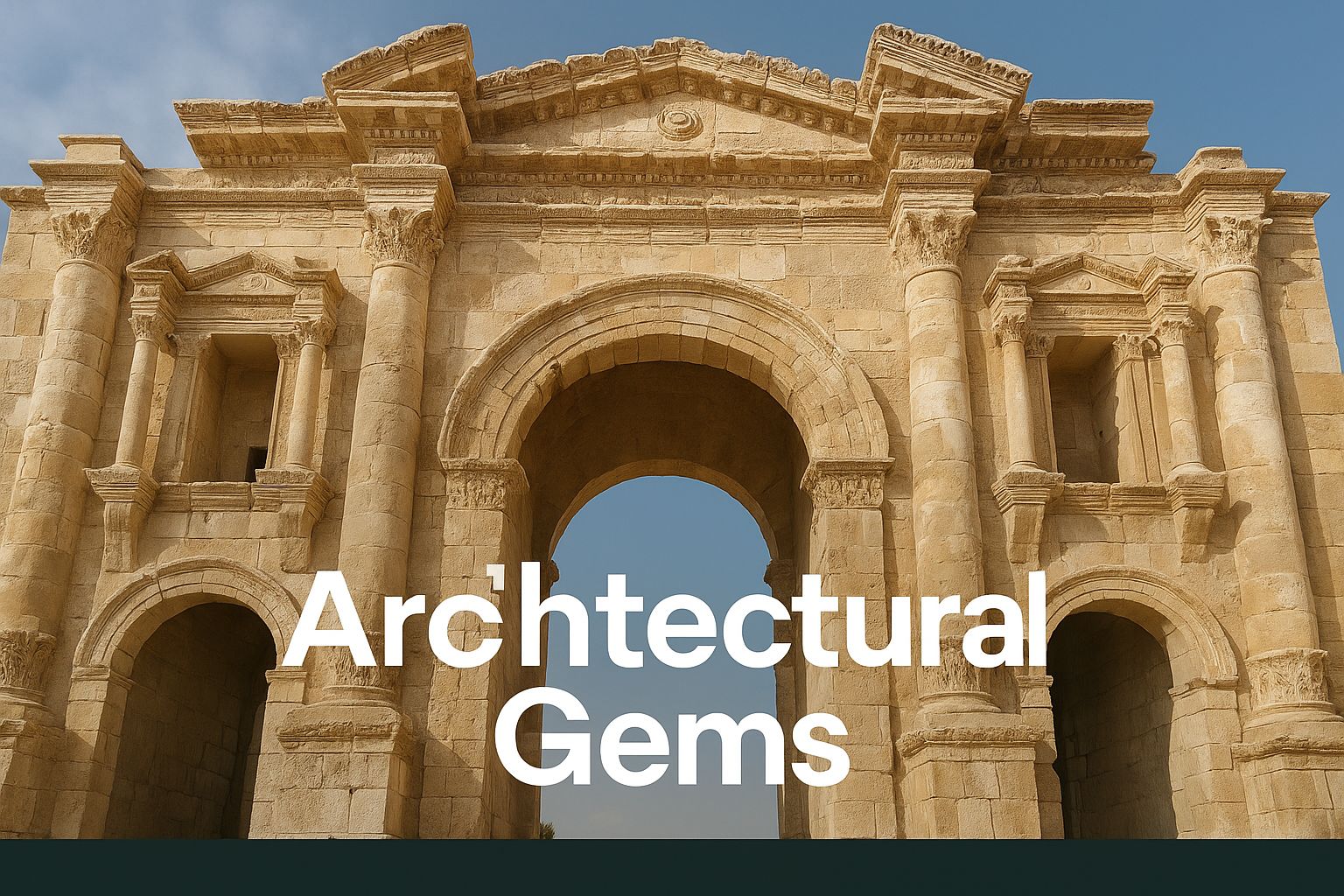
These architectural gems serve as visual storytellers, each one representing a different chapter in Larnaca's long and varied history.
Citium in the Modern Day
Modern preservation techniques are not just about protecting old stones; they are about revealing new insights into daily life in ancient Citium. Archaeologists can now analyse pottery shards to understand trade routes and dietary habits, or examine building layouts to learn about family structures and social hierarchies. This ongoing work helps us understand how our ancestors lived, worked, and thrived in this strategic Mediterranean hub.
The story of Citium is the foundation of the entire island’s heritage. It’s a crucial piece of the puzzle for anyone wanting to understand the island's unique identity. To see how this ancient legacy connects to other historical sites, you might be interested in our guide covering the many fascinating things to do in Cyprus. This deeper historical context truly enriches any visit, turning a simple walk into a journey through time.
Where Faith Meets History: The Church of Saint Lazarus
To step inside the Church of Saint Lazarus is to feel the spiritual pulse of the Larnaca Old Town. This is more than just a beautiful building; for over a thousand years, it has been a destination for pilgrims. Its importance is tied to one of Christianity’s most compelling stories, as it is believed to stand over the final resting place of Saint Lazarus of Bethany—the man Jesus famously resurrected. This direct link elevates a visit from a simple tour to a powerful historical and spiritual encounter.
The church you see today is a stunning example of Byzantine architecture, first built in the late 9th century under Emperor Leo VI. Think of its structure as a historical document written in stone. The original walls and three grand domes showcase Byzantine brilliance, while the impressive bell tower, added later, signals periods of cultural revival. After being damaged during Ottoman rule, it was carefully restored in the 17th century, a process that introduced many of the magnificent features that still captivate visitors.
The Golden Heart of the Church
As you enter, your eyes will be drawn to the iconostasis, a vast and masterfully carved wooden screen that separates the main body of the church from the sanctuary. Gilded and covered in Orthodox Christian icons, it is a spectacular piece of Baroque woodcarving. Each icon isn't just a painting; it's a window into the faith of countless generations. These artworks, some centuries old, portray saints and biblical events, acting as both objects of devotion and a visual guide to the faith. The iconostasis is more than decoration—it's a golden threshold that both separates and connects the earthly world with the divine, a central idea in Orthodox worship.
Beneath the main altar lies a small crypt, offering a space for quiet contemplation. Here, you can walk down the stone steps to view the reputed marble sarcophagus of Saint Lazarus. Although his relics were moved long ago, the profound sense of history in this sacred spot is unmistakable.
A Living Tradition
Beyond its architectural splendour, the Church of Saint Lazarus is a vibrant hub for the community's faith. The religious traditions practised here are not relics of the past but living expressions that continue to define the character of Larnaca Old Town. These festivals connect today's residents to their ancestors. Key celebrations include:
- Saint Lazarus Day: Taking place eight days before Easter, this celebration features a grand procession where the saint's icon is carried through the streets. The entire town comes alive, honouring its patron saint.
- Holy Week: The church becomes the centre for poignant services and processions during the week leading up to Easter, drawing faithful crowds from all over Cyprus.
These events are a powerful reminder that the history here isn't confined to stone and wood. It's carried forward in the songs, prayers, and enduring faith of the people, making the church the undisputed spiritual anchor of this ancient neighbourhood.
Reading Stories Written in Stone and Mortar
Every building in Larnaca Old Town is like a page from Cyprus's architectural history book. Once you learn to read the clues, you'll see fascinating stories everywhere you look. From charming Ottoman-era houses with their distinctive inner courtyards to British colonial structures that reflect more recent history, the neighbourhood showcases an incredible range of building styles. These different aesthetics tell a compelling story of cultural change over centuries.
Think of the architecture as a physical timeline. You can trace the town's evolution from a small port to a significant administrative centre simply by observing the buildings. Each ruling power left its own unique signature, adapting its architectural preferences to the Cypriot climate and available materials. This blend of foreign influence and local adaptation is what gives Larnaca Old Town its unique character.
Recognising the Architectural Fingerprints
Learning to spot the telltale signs of different historical periods transforms a simple walk into a detective game. The narrow, winding streets themselves are a feature of older urban planning, designed for shade and defence. As you explore, keep an eye out for these architectural clues:
- Venetian Echoes: Although much of their influence was military, the Venetians' love for sturdy, functional design can be seen in fortifications and the occasional archway or stone carving that survived later periods.
- Ottoman Influence: Look for houses with a projecting upper floor, known as a ‘sachnisi’. These enclosed wooden balconies provided shade and privacy. Many homes were built around a central, private courtyard, a classic feature designed for family life away from the public gaze.
- British Colonial Style: The British introduced more formal, symmetrical buildings, often with large verandas and neoclassical elements. You’ll typically find these closer to the port and main administrative areas, reflecting their function as government buildings or residences for officials.
What is particularly interesting is how local craftspeople took these foreign styles and made them their own. They creatively adapted designs to suit the intense summer heat and work with local resources like sandstone and wood. This fusion created a distinct architectural dialect that has stood the test of time, proving both beautiful and practical. The result is a town that feels cohesive yet wonderfully diverse.
Preserving a Living Heritage
Today, you can still find modern artisans dedicated to preserving these traditional building techniques. Their work involves a careful balance between maintaining historical authenticity and meeting the needs of the people who live and work in these historic homes. This is not a static museum; it is a community where the past and present are in constant dialogue.
The very buildings that line the streets reflect the social and economic shifts that have shaped Larnaca. For instance, the town’s growth was steady but modest for a long time. Descriptions from the 16th and 17th centuries note that Larnaca consisted of only around 300 houses, most of which were humble structures made of stone and mud-brick. This paints a picture of a small but resilient settlement, a far cry from the bustling port it would later become. You can discover more historical details about Larnaca's early development on Wikipedia. This slow evolution is part of what makes its architectural heritage so rich and layered.
The Neighbours Who Built a Community
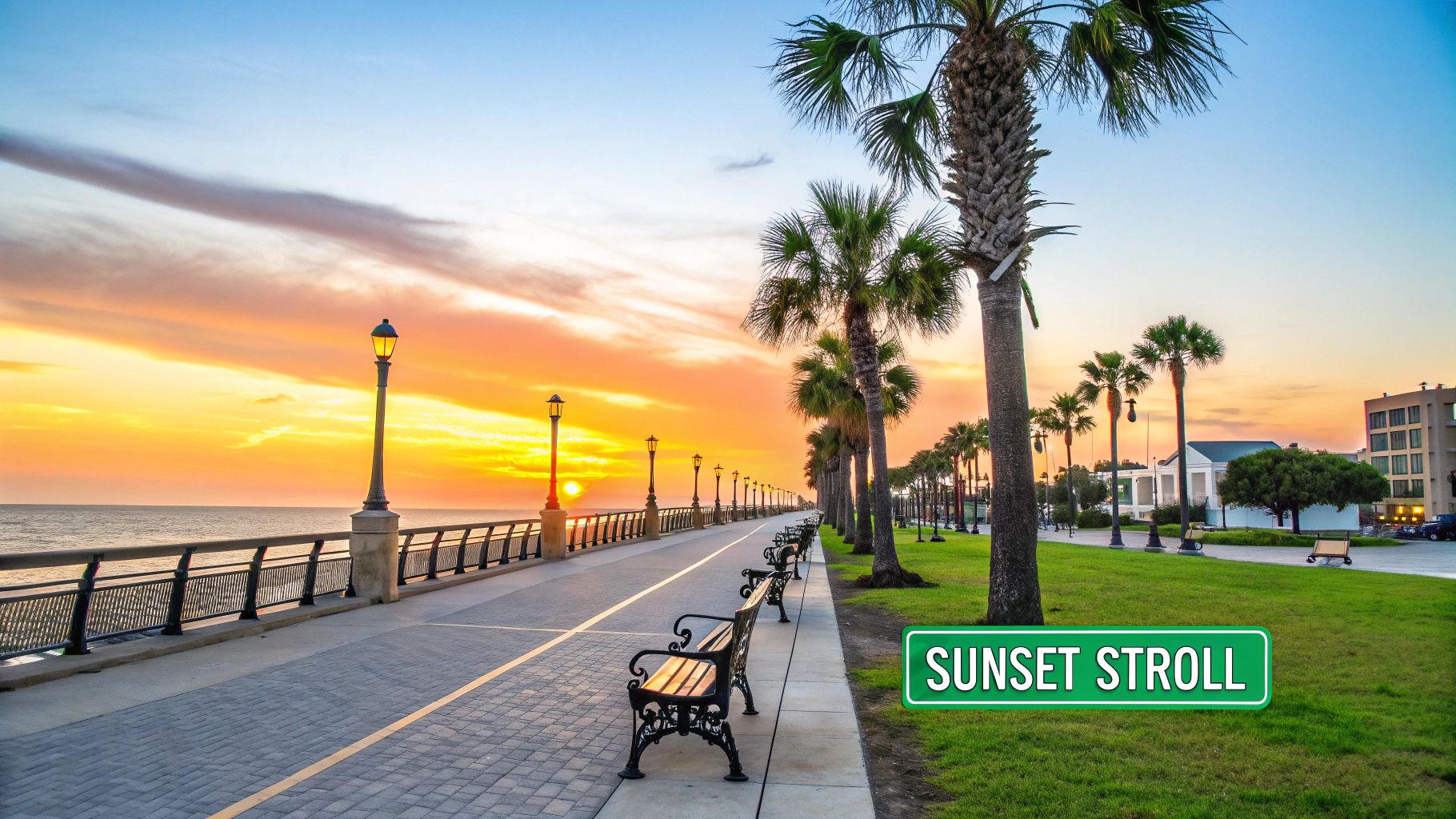
The true spirit of Larnaca Old Town isn’t just found in its ancient stones; it lies in the fascinating story of how diverse groups of people built a single, vibrant community. Throughout its history, this neighbourhood has been a lively mosaic, home to a mix of Greek Cypriots, Turkish Cypriots, Armenians, and Maronites. Later, British colonial administrators and their families added another layer to this cultural fabric, creating an environment defined by genuine fusion rather than simple coexistence.
Think of a neighbourhood where the very layout is designed to bring people together. The winding, narrow streets and small, shared squares of Larnaca Old Town were more than just pathways—they were social hubs. This design naturally encouraged interaction, helping to form relationships that went beyond ethnic and religious divides and cultivated a unique shared identity that still characterises the area.
A Tapestry of Shared Lives
Conversations with elderly residents whose families have lived here for generations reveal a wealth of heartwarming stories. You’ll hear tales of Greek Cypriot families sharing sweets with their Turkish Cypriot neighbours during Bayram, who in turn would gift them coloured eggs and flaounes pastries at Easter. These gestures weren't exceptions; they were a way of life, weaving a strong and resilient social fabric.
This collaborative spirit was evident in many aspects of daily life, both past and present.
- Shared Festivals: Neighbours didn’t simply tolerate each other’s festivities; they actively joined in, transforming religious holidays into community-wide celebrations.
- Culinary Fusion: Recipes were swapped over garden walls, creating new dishes that became neighbourhood staples, blending Greek, Turkish, and Armenian flavours. You can still taste this legacy in many family-run eateries. Food enthusiasts might appreciate our guide to the best restaurants in Cyprus, where many chefs honour this rich history.
- A Common Identity: Over generations, a distinct "Old Town" identity formed, rooted in shared experiences rather than separate ethnic or religious backgrounds.
A Legacy of Coexistence
This blend of populations has always been a key feature of the area. During the Ottoman era, for instance, the town had a mixed yet predominantly Christian population. The 1831 Ottoman census showed that Christians made up approximately 63% of the inhabitants. This figure grew to about 75% by 1891 under British rule, underscoring a long history of multicultural living. You can explore more historical data and learn about Larnaca’s demographic shifts to gain a deeper insight.
Although the political events of the 20th century undoubtedly introduced challenges to this harmony, the Old Town’s tradition of cultural exchange left a lasting mark. It established a foundation of mutual respect and understanding that proved difficult to dismantle.
Today, many residents are descendants of these original families. They carry forward the welcoming and open-minded spirit that has always defined this special place. A visit here is more than just a historical tour; it's a chance to connect with a living legacy of community.
From Farming Village to Heritage Destination
While the Larnaca Old Town today captivates visitors with its rich history and coastal charm, its story begins not with maritime trade, but with the land itself. It might be surprising to learn that this now-bustling neighbourhood was once surrounded by golden fields of barley and wheat. The very foundation of its economy was built on agriculture, creating a community deeply connected to the rhythm of the harvest seasons long before it became the port city we recognise.
This evolution from a quiet farming village to a key Mediterranean hub is a fascinating journey. Think of it like a plant growing towards the light; the agricultural roots provided a stable foundation, allowing the town to stretch outwards towards the sea as new opportunities arose. Over time, maritime trade and the development of the port became the new economic engine, transforming the town’s character and connecting it to the wider world. This shift didn't erase the past but built upon it, creating the layered identity we see today.
From Earth to Sea and Back Again
The economic lifeblood of early Larnaca was deeply rooted in its fertile surroundings. Historical tax records from the Ottoman period paint a vivid picture of this agricultural focus. In the 16th century, for instance, grain cultivation was the dominant source of revenue. In fact, an incredible 51% of all tax income was derived from grain, with barley contributing 35% and wheat another 16%. This data shows just how vital farming was to the community’s prosperity. You can explore more fascinating statistics about the historical economy of the Larnaca region to understand these agricultural beginnings.
To put this into perspective, the following table breaks down the key economic activities in Larnaca during this period, based on Ottoman records.
| Activity | Tax Revenue Percentage | Production Volume | Economic Value |
|---|---|---|---|
| Barley Cultivation | 35% | High | Primary |
| Wheat Cultivation | 16% | Moderate-High | Secondary |
| Cotton Cultivation | 9% | Moderate | Significant |
| Wine Production | 7% | Moderate | Important |
| Other Crops & Crafts | 33% | Varied | Diverse |
| Table Title: Economic Activities in Historic Larnaca | |||
| Table Description: Breakdown of economic activities and tax revenues in 16th century Larnaca based on Ottoman records |
As the table illustrates, while grain was the undisputed king, a diverse range of other products contributed to a resilient local economy, paving the way for future growth.
As the town grew, other industries flourished alongside farming, each adding another thread to the local economic tapestry.
- The Rise of Traditional Crafts: Skills like pottery and weaving, once essential for daily life, have been carefully preserved. Today, these crafts have found a new purpose, serving as cultural attractions that offer visitors a tangible connection to the town's authentic character. Watching an artisan at work is like seeing history come to life.
- The Fishing Industry: The community’s bond with the sea has always been strong. The local fishing industry shaped both the economy and the culture. You can still see traditional fishing boats in the harbour, a reminder of the techniques and seafaring knowledge passed down through generations.
- The Finikoudes Transformation: The development of the famous Finikoudes promenade forever changed the relationship between the Larnaca Old Town and its waterfront. It created new avenues for commerce and leisure, bridging the historic centre with the modern seaside experience while helping to preserve the neighbourhood’s core identity.
Balancing Heritage with Modern Life
Today, heritage tourism is the lifeblood of the Old Town. Local business owners, many from families who have lived here for centuries, are the custodians of this legacy. They share compelling insights into how tourism supports the community, allowing them to maintain the historic buildings and keep local traditions alive. However, they also face the ongoing challenge of balancing preservation with the practical needs of modern life—a delicate act that ensures the Old Town remains not just a destination, but a vibrant, living home.
Your Insider's Guide to Authentic Exploration
Now that you have a sense of the history layered beneath your feet, let's look at the practical side of exploring the Larnaca Old Town of today. Think of this as getting tips from a local friend, someone who can show you the hidden corners and real experiences that many visitors overlook. The true pleasure of this neighbourhood isn't just in seeing its famous sights, but in feeling its living, breathing pulse.
Navigating the Must-See Landmarks
While simply wandering is a joy in itself, having a few key destinations can give your exploration some structure. These landmarks are the anchors of the Old Town's story, each offering a unique window into its rich past. Consider starting your journey with these essential stops:
- Larnaca Archaeological Museum: This is where the story of ancient Kition truly comes to life. It houses artefacts discovered at the Kition archaeological site, giving you vital context for the ruins you’ll find throughout the area.
- Larnaca Medieval Fort: Standing guard at the edge of the harbour, this fort is a silent witness to centuries of maritime history. It’s a brilliant spot for understanding the town's strategic importance and for its commanding views of the coastline.
- Traditional Craft Workshops: Tucked away in the narrow side streets, you can find artisans practising skills passed down through generations. From pottery to intricate lacework, watching these craftspeople work is a direct link to the town's cultural heritage.
The image below captures modern Larnaca, with the Old Town as its historic heart, set against the lively waterfront.
This aerial view shows the dense, historic layout of the Old Town, contrasting with the newer developments and the wide sweep of the Finikoudes promenade along the Mediterranean Sea.
Savouring the Flavours of the Old Town
The food scene here perfectly mirrors the Old Town's character. You’ll discover traditional family-run tavernas, where recipes have been perfected over decades, sitting alongside creative restaurants that put a modern twist on Cypriot dishes. The secret is to look beyond the main tourist strips. For a genuine taste, explore the alleyways that branch off from the Church of Saint Lazarus.
A good rule of thumb is to follow the locals. If you spot a small eatery buzzing with Greek conversation around lunchtime, you’ve likely found a hidden treasure. Don't hesitate to ask for the "special of the day"—it's often a showcase of the freshest seasonal ingredients from the local market.
Tips for a Truly Authentic Visit
A bit of local insight can transform your visit from a simple tour into a memorable connection. These tips will help you experience the Larnaca Old Town with the respect and appreciation it deserves.
| Tip Category | Insider Advice |
|---|---|
| Best Time to Visit | Early mornings (before 10:00 AM) are magical. The light is soft, and the streets are quiet. Late afternoons offer a golden glow perfect for photography as locals begin their evening stroll. |
| Photogenic Spots | Look for colourful doorways and flower-draped balconies in the streets west of the main square. The contrast of old stone against vibrant bougainvillaea is classic Cyprus. |
| Respectful Engagement | This is a living community. Greet shopkeepers with a friendly "Yassas" (hello). When taking pictures of buildings, remember these are people's homes. Keep conversations quiet near residential windows. |
| Local Events | Check the schedule for local festivals. Religious processions, particularly around Easter, and seasonal markets provide an incredible, authentic cultural experience and a chance to meet local producers and residents. |
By blending landmark visits with unhurried, observant strolls, you'll begin to notice the small details that give this place its character. The true soul of Larnaca Old Town reveals itself slowly, rewarding those who take the time to look more closely.
If you're fitting this exploration into a broader trip, our comprehensive guide has more ideas. To help plan your journey across the island, take a look at our suggested Cyprus travel itinerary for further inspiration.
Ready to plan your unforgettable Cypriot adventure? From hidden beaches to mountain retreats, SayCyprus.com is your ultimate guide to discovering the heart and soul of this beautiful island. Explore our guides and start your journey today.




